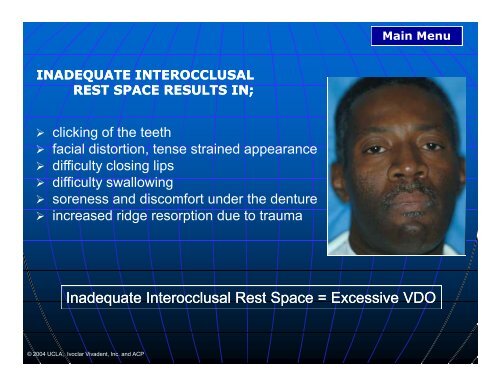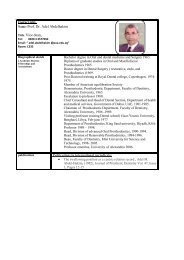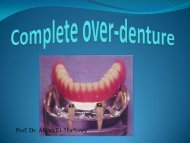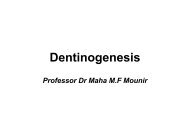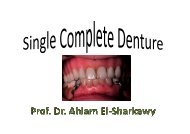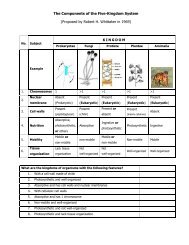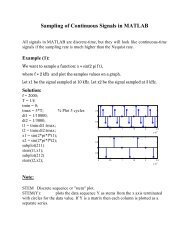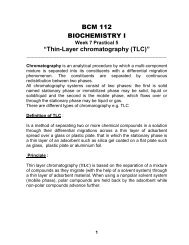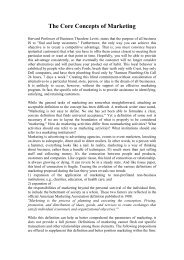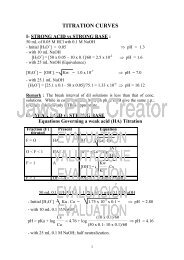Inadequate Interocclusal Inadequate Interocclusal Rest Space ...
Inadequate Interocclusal Inadequate Interocclusal Rest Space ...
Inadequate Interocclusal Inadequate Interocclusal Rest Space ...
You also want an ePaper? Increase the reach of your titles
YUMPU automatically turns print PDFs into web optimized ePapers that Google loves.
Main Menu<br />
INADEQUATE INTEROCCLUSAL<br />
REST SPACE RESULTS IN;<br />
clicking of the teeth<br />
facial distortion, tense strained appearance<br />
difficulty closing lips<br />
difficulty swallowing<br />
soreness and discomfort under the denture<br />
increased ridge resorption due to trauma<br />
<strong>Inadequate</strong> <strong>Interocclusal</strong> <strong>Rest</strong> <strong>Space</strong> = Excessive VDO<br />
© 2004 UCLA, Ivoclar Vivadent, Inc. and ACP
Main Menu<br />
EXCESSIVE INTEROCCLUSAL REST SPACE RESULTS IN;<br />
reduced interarch distance when the teeth are in occlusion<br />
overclosure is potentially damaging to the TMJ<br />
normal tongue space is limited<br />
facial distortion, chin is closer to nose, commissure of the lips<br />
turns down , lips loose their fullness<br />
muscles of facial expression loose their tonicity,<br />
face appears flabby<br />
angular cheilitis is sometimes attributed<br />
to overclosure<br />
Excessive <strong>Interocclusal</strong> <strong>Rest</strong> <strong>Space</strong>= <strong>Inadequate</strong> VDO<br />
© 2004 UCLA, Ivoclar Vivadent, Inc. and ACP
Main Menu<br />
CLOSEST SPEAKING SPACE<br />
”s” sounds<br />
count from 60-70<br />
Measures vertical dimension when the mandible and<br />
muscles involved are in physiologic function of speech.<br />
The final test that we use to determine if the vertical<br />
dimension of occlusion that we have chosen is correct.<br />
Measure VDO of existing denture and compare.<br />
© 2004 UCLA, Ivoclar Vivadent, Inc. and ACP
CENTRIC RECORDS<br />
Main Menu<br />
Centric Occlusion(CO):<br />
Definition: is the relation of opposing occlusal surfaces that<br />
provide maximum intercuspation.<br />
Centric Relation(CR):<br />
Definition: a maxillomandibular relationship in which the<br />
condyles articulate with the thinnest avascular portion of their<br />
respective discs with the complex in the anterior-superior<br />
position against the slopes of the articular eminences.<br />
Centric occlusion with teeth present is a tooth-to-tooth<br />
relation,whereas centric relation, is a static position, is a<br />
bone to bone relation.<br />
© 2004 UCLA, Ivoclar Vivadent, Inc. and ACP
CENTRIC RECORDS<br />
ISO Compound<br />
Main Menu<br />
1. Functional (Chew in)<br />
2. Graphic (Intraoral or extraoral tracings)<br />
3. Physiologic(<strong>Interocclusal</strong> records)<br />
a. Waxes (i.e Alu-wax)<br />
b. Impression Compounds (ISO compound)<br />
c. ZOE paste<br />
<br />
<br />
<br />
<br />
waxes are capable of making a record<br />
upon contact and the jaws can be<br />
separated at once.<br />
compound and ZOE must be maintained<br />
in contact until the material is hard<br />
waxes are easily distorted and unless<br />
extreme care is exercised when the records<br />
are positioned, an error can occur<br />
compound & ZOE will break before they<br />
will distort<br />
© 2004 UCLA, Ivoclar Vivadent, Inc. and ACP
ALTERNATIVE MATERIALS<br />
Main Menu<br />
Material Properties<br />
<br />
<br />
<br />
<br />
<br />
Virtual is an addition-reaction silicone<br />
Thixotropic viscocity<br />
Fast setting time<br />
Dimensionally stable<br />
Final hardness (95 Shore-A)<br />
Application<br />
<br />
<br />
<br />
Inject material on occlusal surfaces<br />
Guide patient into a CR position<br />
Hold the position until material is set (60 sec.)<br />
© 2004 UCLA, Ivoclar Vivadent, Inc. and ACP
CENTRIC RECORDS<br />
Main Menu<br />
The technique can be divided into 2 steps:<br />
1. A tentative record using wax occlusion<br />
rims attached to accurate stable<br />
record bases.<br />
2. <strong>Interocclusal</strong> check records with teeth<br />
arranged during the final try-in.<br />
Alu-wax<br />
© 2004 UCLA, Ivoclar Vivadent, Inc. and ACP
CENTRIC RELATION RECORD<br />
Main Menu<br />
1. CR is a reference point in recording maxillomandibular<br />
relations. It is independent of tooth contact. It allows us<br />
to record the anterior-posterior position of the mandible.<br />
2. It can be verified and repeated<br />
3. It is a starting point for developing occlusion. For denture<br />
occlusion CR=CO.<br />
4. It’s a functional position, although fleeting in nature.<br />
*** CR should be recorded at the proper VDO<br />
© 2004 UCLA, Ivoclar Vivadent, Inc. and ACP
CENTRIC RELATION RECORD<br />
Main Menu<br />
The primary requirements for making a CR record:<br />
1. Record the horizontal relation of the mandible to the<br />
maxilla at the proper VDO.<br />
2. Exert equal vertical pressure on the record base while<br />
making the record.<br />
3. Avoid distortion of the record until the casts have been<br />
accurately mounted.<br />
4. A record that cannot be repeated or<br />
verified is not acceptable.<br />
© 2004 UCLA, Ivoclar Vivadent, Inc. and ACP
RECORDING CENTRIC RELATION<br />
Main Menu<br />
• Before making the final<br />
record check for<br />
interferences between<br />
the record bases<br />
• Adjust record bases as necessary<br />
© 2004 UCLA, Ivoclar Vivadent, Inc. and ACP
CENTRIC RELATION RECORD<br />
Main Menu<br />
• Have patient practice<br />
closing gently in a<br />
retruded position before<br />
making the final record<br />
Making CR records consists of<br />
two phases:<br />
1. Getting the entire mandible retruded<br />
-Bimanual technique<br />
2. Positioning the condyle-disc disc assembly<br />
in the uppermost anterior position.<br />
© 2004 UCLA, Ivoclar Vivadent, Inc. and ACP
PROTRUSIVE RECORD<br />
Main Menu<br />
• The movement the mandible and<br />
condyle is downward and forward.<br />
The angle of the slide varies from patient<br />
to patient and from side to side.<br />
• We will use this record to set condylar<br />
inclinations so that the articulator can<br />
perform eccentric movements<br />
equivalent to the relative movements<br />
of the mandible to the maxillae. This<br />
makes it possible to arrange the teeth<br />
for complete dentures in balanced<br />
occlusion.<br />
• The mandible must be protruded a<br />
minimum of 5-6 mm when making<br />
the record.<br />
© 2004 UCLA, Ivoclar Vivadent, Inc. and ACP
Main Menu<br />
Maxillomandibular records summary<br />
1. Seat pt. comfortably with head upright.<br />
2. Contour and mark the maxillary wax occlusion rim (lip<br />
contour, midline, occlusal plane).<br />
3. Make a facebow transfer record and mount the maxillary<br />
cast.<br />
4. Establish (a) VDR & (b) VDO<br />
5. Make a tentative CR record at the proper VDO<br />
6. Use CR record to mount the mandibular cast on the<br />
articulator.<br />
7. Make a Protrusive record to set condylar inclinations.<br />
© 2004 UCLA, Ivoclar Vivadent, Inc. and ACP


